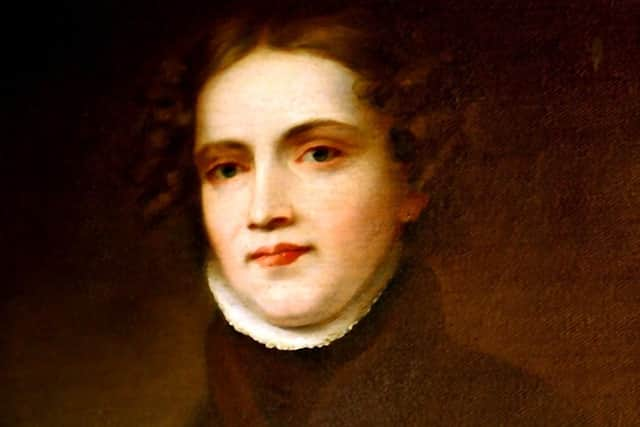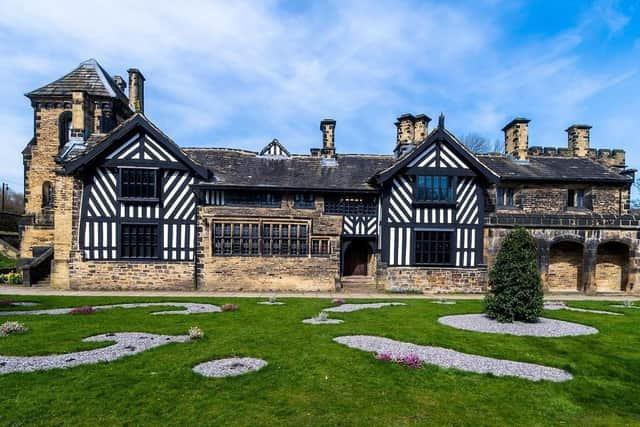The real Gentleman Jack: Who is Anne Lister? The life of the Yorkshire diarist who inspired BBC series starring Suranne Jones and was filmed in Halifax
Anne Lister is one of the most notable figures in Yorkshire and is a constant draw to Calderdale due to her sexual revelations in her diaries. She has been dubbed ‘the first modern lesbian’.
She was born into a minor landowning family at Shibden in Calderdale and had several lesbian love affairs from her school days and onwards.
Advertisement
Hide AdAdvertisement
Hide AdThere have been various films and TV shows that follow Anne’s life including Sally Wainwright’s series Gentleman Jack which was predominantly filmed in Halifax and often filmed in Shibden Hall.


The BBC series stars Suranne Jones as Anne Lister, Sophie Rundle as Ann Walker, Amelia Bullmore as Eliza Priestly (nee Raine), Gemma Whelan as Marian Lister, Gemma Jones as Anne’s aunt and Timothy West as Captain Jeremy Lister, Anne’s father.
Here is everything you need to know about Anne Lister and what made her so famous.
Early life of Anne Lister
She was the second child and eldest daughter of Captain Jeremy Lister who, as a young man, served with the British 10th Regiment of Foot in the Battles of Lexington and Concord in the 1775 American War of Independence.


Advertisement
Hide AdAdvertisement
Hide AdHe married a woman called Rebecca Battle, from Welton, in August 1788, whose first child was born a year later but died the same year.
Anne Lister was born in Halifax on April 3, 1791. Two years later the family moved to an estate named Skelfler House at Market Weighton, where Anne spent her earliest childhood.
Jeremy and Rebecca had four sons and three daughters. Their second son, Samuel, was close to Anne and was born two years after her. Only Anne and her youngest sister, Marian, survived past 20 years old.
When Anne was seven years old, she was sent to a school run by women called Mrs Hagues and Mrs Chettle in Agnesgate, Ripon.


Advertisement
Hide AdAdvertisement
Hide AdHowever, between 1801 and 1804, she was homeschooled by the Reverend George Skelding, the vicar of Market Weighton. When she visited her aunt Anne and uncle James at Shibden Hall, Mrs Mellin taught her.
During her schooling, Anne discovered her interest in classical literature and in a surviving letter to her aunt from February 3, 1803, a young Anne said: “My library is my greatest pleasure… The Grecian History had pleased me much.”
She met her first love Eliza Raine in 1805 when she was sent to the Manor House School in York.
Eliza was half Indian, the daughter of an East India Company surgeon in Madras and was brought to Yorkshire following his death and was set to inherit a significant amount of money.
Advertisement
Hide AdAdvertisement
Hide AdAnne and Eliza shared a room at the boarding school, but Anne was asked to leave after two years. Eliza had hoped to live with Anne in their adulthood but Anne had started affairs with other women including Isabella Norcliffe and Mariana Belcombe. Eliza ended up being committed to Clifton House Asylum after the knowledge of Anne’s affairs left her in despair and frustration. The asylum was run by Mariana’s father, William, in 1814, so Eliza was later transferred to Terrace House in Osbaldwick, where she died on January 31, 1860. She is currently buried in the Osbaldwick churchyard across the road.
Anne Lister’s diaries
Throughout Anne’s life, she wrote a 5,000,000-word diary which began in 1806 as pieces of paper, recording in secret code parcels sent to and from Eliza and ended up the 26 quarto volumes, ending at her death in 1840.
As well as her handwriting being hard to decode, around one-sixth of the diary is encrypted in a simple code that Eliza and Anne had created, combining the Greek alphabet, zodiac, punctuation and mathematical symbols. It describes in vivid detail her lesbian identity and affairs, including the methods she used for seduction.
These diaries also include her thoughts on the weather, social events, national events, and her business interests. Most of her diary focusses on her daily life, and not just her sexual encounters, and offers in-depth analysis on social, political and economic events of that period.
Advertisement
Hide AdAdvertisement
Hide AdThe cypher she used in her diaries was decoded by the last resident of Shibden Hall, John Lister and his friend, Arthur Burrell. Once they had figured out the contents of her diaries, John was advised by Arthur to burn them, but instead John hid the diaries behind a panel at Shibden Hall.
Her diaries were added to the register of the UNESCO Memory of the World Programme in 2011 and the register citation said that while a valuable account of the times, it was the “comprehensive and painfully honest account of lesbian life and reflections on her nature which have made these diaries unique. They have shaped and continue to shape the direction of UK Gender Studies and Women’s History.”
Anne’s long-term partner Ann Walker’s own journal was discovered in 2020 and while it is brief in comparison to Anne’s, covering June 1834 to February 1835, it also includes a pivotal period that weaves through the corresponding narratives in Anne’s diary.
Anne Lister’s life at Shibden Hall
Anne inherited the estate following her uncle’s death in 1826, but only had control over part of its income until both her father’s and aunt’s deaths in 1836, when their shares of the income were left to her. Her wealth allowed her some semblance of freedom to live they way she wanted.
Advertisement
Hide AdAdvertisement
Hide AdHer financial resources also came from properties in town, shares in the canal and railway industries, mining, and stone quarries, as well as the agricultural tenancy. Anne used the income from this varied portfolio to finance her two passions, the renovation of Shibden Hall, and European travel.
Anne was described as having a ‘masculine appearance’ and one of her lovers, Mariana, was originally ashamed to be seen in public with her due to the responses she would get on Anne’s appearance.
She would dress entirely in black, which was the normal attire for gentlemen at the time, and took part in various activities that were not often perceived to be for women at the time, including opening and owning a colliery.
She was often referred to as ‘Gentleman Jack’ in some areas and Mariana and Anne were in a relationship for 20 years, including a period during which Mariana was married and to which her husband became resigned to. In 1822, they visited the Ladies of Llangollen at Plas Newydd in Llangollen.
Advertisement
Hide AdAdvertisement
Hide AdAnne first met her long term partner, Ann Walker, on various occasions in the 1820s, however, it wasn’t until 1832, when Ann became a wealthy heiress, that she was an influential figure in Anne’s life.
The two women took communion together on Easter Sunday (March 30, 1834) in Holy Trinity Church in Goodramgate, York and considered themselves married, but without legal recognition. The church has been described as “an icon for what is interpreted as the site of the first lesbian marriage to be held in Britain”, and the building now has a commemorative blue plaque. The couple lived together in Shibden Hall until Anne’s death in 1840.
Ann’s fortune was used to renovate Shibden Hall and the property’s waterfall and lake and later Anne significantly improved the building by using her own design. In 1838, she added a Gothic tower to the main house, to serve as her private library as well as a tunnel which was dug under the building which allowed the staff to move around without interrupting her.
Throughout her life, Anne had a strong Anglican faith and also remained a political Conservative supporter “interested in defending the privileges of the land-owning aristocracy”.
Anne Lister’s travels
Advertisement
Hide AdAdvertisement
Hide AdShe enjoyed travelling, however, her biographer Angela Steidele suggests her trips in later life were also her method of avoiding the self-realisation that she had failed at everything she set her mind to do. Her first trip was to continental Europe in 1819, when she was 28 years old, and she travelled with her 54-year-old aunt, also called Anne Lister, on a two-month holiday to France.
In 1824, she returned to Paris and stayed until the following year, then in 1826 she travelled again to Paris with her aunt, where she resumed an affair she had with a widow named Maria Barlow.
She travelled on a tour of northern Italy and Switzerland with Maria and her aunt Anne in 1827 and returned to Shibden Hall the following year before she travelled extensively in Scotland with a woman named Sibella MacLean.
For two years from 1829, she travelled from Paris to Belgium and Germany before heading south to the Pyrenees, where she hiked as well as crossed the border into Spain. While she was in Spain she demonstrated her strong adventurous streak and physical fitness by ascending Monte Perdido which is 11,007ft, the third highest peak in the Pyrenees.
Advertisement
Hide AdAdvertisement
Hide AdHer family life became so unbearable for her in 1831 that she almost left again immediately to visit the Netherlands for a short trip with Mariana Lawton (nee Belcombe). Between 1826 and 1832, she only spent a short time at Shibden Hall.
She visited France and Switzerland again in 1834, this time for her honeymoon with Ann Walker and shortly after returning in 1838, she headed back to the Pyrenees and completed the first ‘official’ ascent of the Vignemale, which is considered the highest peak in the French Pyrenees, which required a 10-hour hike to reach the summit and an additional seven hours to descend.
Her last and greatest trip started in 1939, when she left Shibden Hall in June with Ann and two servants and travelled in their own carriage through France, Denmark, Sweden and Russia, arriving in St Petersburg in September and in Moscow in October.
Anne left Moscow in February 1840 with a reluctant Ann Walker in a new Russian carriage and very warm clothing. They travelled south, along the frozen Volga river, to the Caucasus. Sometimes they needed a military escort and the two women were a source of curiosity to the people they visited. Anne wrote in her diary: “The people coming in to look at us as if we were some strange animals such as they had not seen the like before.”
Anne Lister’s death
Advertisement
Hide AdAdvertisement
Hide AdShe died at the age of 49 on September 22, 1840, following a fever at Koutais (now Kutaisi in Georgia) while travelling with Ann Walker.
Ann brought Anne’s body back to the UK, where she was buried in Halifax Minster on April 29, 1841, and her tombstone was rediscovered in 2000 after it had been covered by a floor in 1879.
In her will, Anne’s estate was left to her paternal cousins, but Ann was given a life interest and after being declared to be of ‘unsound mind’, Ann spent time briefly in Terrace House, and then in the London area with her sister and brother-in-law.
She returned to Shibden Hall in 1845 and moved back to her family’s estate in Lightcliffe in 1848. She died in 1854 at her childhood home.
Comment Guidelines
National World encourages reader discussion on our stories. User feedback, insights and back-and-forth exchanges add a rich layer of context to reporting. Please review our Community Guidelines before commenting.
